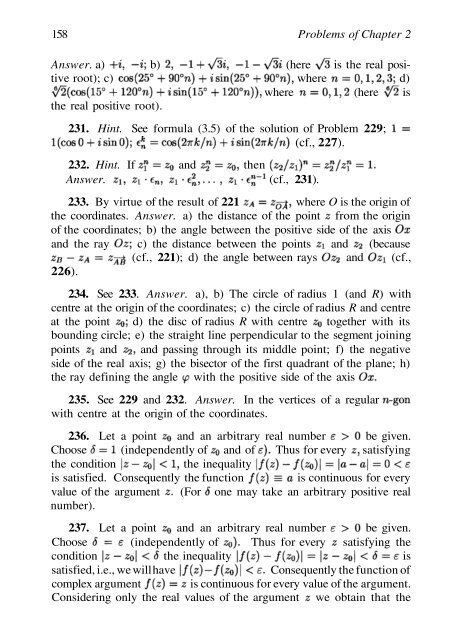Abel's theorem in problems and solutions - School of Mathematics
Abel's theorem in problems and solutions - School of Mathematics
Abel's theorem in problems and solutions - School of Mathematics
You also want an ePaper? Increase the reach of your titles
YUMPU automatically turns print PDFs into web optimized ePapers that Google loves.
158 Problems <strong>of</strong> Chapter 2<br />
Answer. a) b) (here is the real positive<br />
root); c) where d)<br />
where (here is<br />
the real positive root).<br />
231. H<strong>in</strong>t. See formula (3.5) <strong>of</strong> the solution <strong>of</strong> Problem 229;<br />
(cf., 227).<br />
232. H<strong>in</strong>t. If <strong>and</strong> then<br />
Answer. (cf., 231).<br />
233. By virtue <strong>of</strong> the result <strong>of</strong> 221 where O is the orig<strong>in</strong> <strong>of</strong><br />
the coord<strong>in</strong>ates. Answer. a) the distance <strong>of</strong> the po<strong>in</strong>t from the orig<strong>in</strong><br />
<strong>of</strong> the coord<strong>in</strong>ates; b) the angle between the positive side <strong>of</strong> the axis<br />
<strong>and</strong> the ray c) the distance between the po<strong>in</strong>ts <strong>and</strong> (because<br />
(cf., 221); d) the angle between rays <strong>and</strong> (cf.,<br />
226).<br />
234. See 233. Answer. a), b) The circle <strong>of</strong> radius 1 (<strong>and</strong> R) with<br />
centre at the orig<strong>in</strong> <strong>of</strong> the coord<strong>in</strong>ates; c) the circle <strong>of</strong> radius R <strong>and</strong> centre<br />
at the po<strong>in</strong>t d) the disc <strong>of</strong> radius R with centre together with its<br />
bound<strong>in</strong>g circle; e) the straight l<strong>in</strong>e perpendicular to the segment jo<strong>in</strong><strong>in</strong>g<br />
po<strong>in</strong>ts <strong>and</strong> <strong>and</strong> pass<strong>in</strong>g through its middle po<strong>in</strong>t; f) the negative<br />
side <strong>of</strong> the real axis; g) the bisector <strong>of</strong> the first quadrant <strong>of</strong> the plane; h)<br />
the ray def<strong>in</strong><strong>in</strong>g the angle with the positive side <strong>of</strong> the axis<br />
235. See 229 <strong>and</strong> 232. Answer. In the vertices <strong>of</strong> a regular<br />
with centre at the orig<strong>in</strong> <strong>of</strong> the coord<strong>in</strong>ates.<br />
236. Let a po<strong>in</strong>t <strong>and</strong> an arbitrary real number be given.<br />
Choose (<strong>in</strong>dependently <strong>of</strong> <strong>and</strong> <strong>of</strong> Thus for every satisfy<strong>in</strong>g<br />
the condition the <strong>in</strong>equality<br />
is satisfied. Consequently the function is cont<strong>in</strong>uous for every<br />
value <strong>of</strong> the argument (For one may take an arbitrary positive real<br />
number).<br />
237. Let a po<strong>in</strong>t <strong>and</strong> an arbitrary real number be given.<br />
Choose (<strong>in</strong>dependently <strong>of</strong> Thus for every satisfy<strong>in</strong>g the<br />
condition the <strong>in</strong>equality is<br />
satisfied, i.e., we will have Consequently the function <strong>of</strong><br />
complex argument is cont<strong>in</strong>uous for every value <strong>of</strong> the argument.<br />
Consider<strong>in</strong>g only the real values <strong>of</strong> the argument we obta<strong>in</strong> that the

















